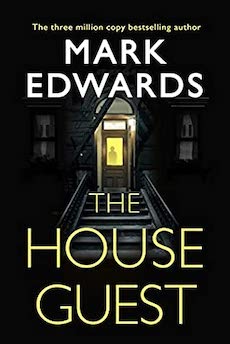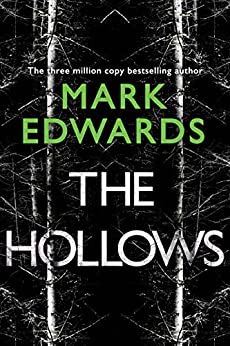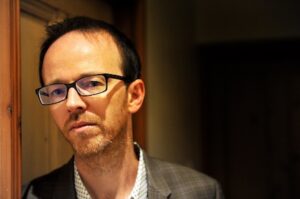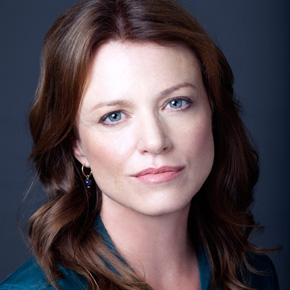Mark Edwards: Proverbial needle, proverbial haystack
by Karin Salvalaggio
“Like a Reacher, but with a hero like the rest of us.” Linwood Barclay
In No Place to Run’s opening sequence, Francesca Gilbert is seventy-five years old, mourning the recent loss of a husband, and six hundred miles into her train journey home. Dawn is breaking across a clearing in a Northern California forest when Francesca sees a young woman with “vivid auburn hair” being chased by a man. The woman stumbles and falls and their eyes meet briefly through the carriage window. Francesca is certain it’s Scarlett Faith, a British teenager who went missing two years earlier while visiting her older brother Aidan in Seattle. Aidan puts his reservations aside and travels by train to the exact location of the sighting to investigate Francesca’s claim. The forests are endless, and the terrain is rugged, and Scarlett could be anywhere or nowhere. Out of his depth and ill-equipped, Aidan begins a terrifying trip into the dark heart of the Golden State.
Aidan isn’t an obvious hero. He is an ‘everyman’ who drinks oat lattes, orders Ubers, FaceTimes his parents and makes a living writing code. His investigative skills don’t extend beyond Google and he has never held a gun, but he’s made it his responsibility to find his sister and return her home safely to Wolverhampton where his parents are quietly imploding. Aidan’s motivations are straightforward and universal: he wants to protect his family and make amends. It is this clarity of purpose that drives most of the novel’s action.
It’s a landscape we’ve all seen in holiday photos, it’s a place we’ve all longed to visit, but this isn’t a roadmap for your long-dreamed-for California road trip.”
No Place to Run is a fast-paced novel that rarely gives the reader or its characters an opportunity to rest. One minute we’re in the sinister backwater town of Eaglewood, where Aidan is making a tentative start to his search, and the next we’re deep in the woods in remote Modoc County living amongst a group of eco-warriors out to save the world. A couple of days later, we’re in Humboldt County, one of the densest cannabis-growing regions in the state. California provides a stunning backdrop. Mount Shasta looms over rural towns and dense forests. Ancient redwoods line the banks of the Eel River. It’s a landscape we’ve all seen in holiday photos, it’s a place we’ve all longed to visit, but this isn’t a roadmap for your long-dreamed-for California road trip.
Environmentalism is a theme that weaves its way through the narrative. There is a clear and present danger to the novel’s characters, but our planet is also in peril. Evidence of global warming and climate change can be seen everywhere. It’s summer and temperatures are soaring. Wildfires have scorched the forests around Eaglewood, and other fires continue to burn throughout the state. While most people are doing their bit for the planet and living a carbon-neutral life, others are moving beyond protesting against government inaction and taking more extreme measures.
California is beautiful, but its beauty has a sharp edge, and you don’t have to travel far to find the wounds. I was curious to explore the inspiration behind No Place to Run and why Mark chose California as a setting.
Karin: “Francesca was six hundred miles into her journey, and dawn was breaking over the forest, when she saw the woman come running out of the trees towards the tracks.” Your novel’s opening scene feels like it may have come to you in a dream. Did this the first scene inspire the rest of the novel, or did you have a clear vision of what you were going to write about from the outset?
That’s very perceptive of you! It was a daydream rather than a dream, but the book started with an image that came to me out of nowhere: a teenage girl being chased by a man across a forest clearing, with an older woman watching her from a train as it rumbled past. I knew it was somewhere in America but not precisely where and I didn’t know who any of these characters were. I thought it would be interesting, however, if the woman on the train recognised the girl in the clearing from posters and TV coverage. I then came up with my central character – the brother of the missing teenager – and figured the rest out from there.
Are there any particular American authors that have influenced your writing, and in what way?
I’ve been a fan of American authors since I started reading ‘grown-up’ books as a young teenager. The obvious one is Stephen King, who greatly influenced the kind of stories I wanted to tell: extraordinary, often scary, things happening to ordinary people. The big influence on No Place To Run is Harlan Coben, along with the Canadian author Linwood Barclay. They both write ‘everyman’ thrillers that are pacey, easy to read and often feature people running around in the woods with guns. That was the style I was going for with this book. I should also mention Michael Connelly because I love his simple prose and immaculate plotting skills plus the way he’s so good at creating atmosphere. I actually read one of his books while I was on the Coast Starlight, the train featured in the novel, when I went to America to research this book.
Writing about a Brit who has barely ever seen a gun, let alone fired one, coming up against armed heavies and figuring out how to cope makes it more tense and more relatable. It’s also fun to explore the culture clash.”
Your protagonist Aidan Faith is British but has lived and worked in Seattle for five years. You could have had a central character who was American but chose to tell the story through the eyes of an expat. What were the advantages and disadvantages in choosing an outsider’s point of view?
Although sections of this book are told from the POV of American characters, I needed to make my central character British for both practical and artistic reasons. The practical reason is that I need to write my books in British English and that would be peculiar with an American protagonist! Artistically, I enjoy writing about a ‘fish out of water’. Someone who is ill-equipped to deal with the crazy shit he encounters. Writing about a Brit who has barely ever seen a gun, let alone fired one, coming up against armed heavies and figuring out how to cope makes it more tense and, I think, more relatable for my core UK audience. It’s also fun to explore the culture clash between our two countries.
No Place to Run is set in towns, farms and ranches that butt up against Northern California’s vast wilderness. The sense of lawlessness is pervasive. No one is safe. I understand that you went on a research trip to California and Oregon. What surprised you the most about the locations you visited? Did your writing style change in response to the setting? Were you inspired to write more stories set in this part of the US?

 No Place To Run is my third book in a row to be set in the US, and yes, interestingly (to me anyway) the style of these books is a little different to my UK-set books. This one and The House Guest are more action-packed and have huge casts. The other, The Hollows, is my tribute to the aforementioned Stephen King and set in the woods of Maine. There’s something about the vast open spaces of America that helps my books expand and step outside the houses and flats where most of my British books are set. I’m not sure what surprised me. How slow the trains are? Perhaps it was the weird hippie vibe of Mount Shasta with all its crystal shops, or the town of Weed which had nothing but a diner and a shop selling souvenirs capitalising on Weed’s name. I love America and find it so exciting to visit and explore, and hopefully that energy comes through on the page. Having said all that, I’m coming back to the UK for the next one and setting it mostly indoors!
No Place To Run is my third book in a row to be set in the US, and yes, interestingly (to me anyway) the style of these books is a little different to my UK-set books. This one and The House Guest are more action-packed and have huge casts. The other, The Hollows, is my tribute to the aforementioned Stephen King and set in the woods of Maine. There’s something about the vast open spaces of America that helps my books expand and step outside the houses and flats where most of my British books are set. I’m not sure what surprised me. How slow the trains are? Perhaps it was the weird hippie vibe of Mount Shasta with all its crystal shops, or the town of Weed which had nothing but a diner and a shop selling souvenirs capitalising on Weed’s name. I love America and find it so exciting to visit and explore, and hopefully that energy comes through on the page. Having said all that, I’m coming back to the UK for the next one and setting it mostly indoors!
Private gun ownership is rare in the UK, so crime novelists have to get creative when it comes to killing off characters. This isn’t the case in the US where guns are now the leading cause of death. If you want to write authentic American crime fiction, you’re going to have to include guns, which isn’t as easy as it seems. Private militias feature in your novel, so you had to bring some serious firepower into some of your scenes. Was this something new for you? If so, how did you find writing the scenes that involved firearms?
In my British books I usually have to kill characters by pushing them off high buildings, with the occasional fire or drowning, so it was liberating to be able to use guns! I came back from my research trip to America with several gun magazines in my suitcase, and had to learn about the various parts of a firearm and how they work. It was challenging. Luckily my editor is American and was able to help with this – not that he’s a big gun enthusiast. He kept asking me what kind of gun the characters were using. It can’t be just ‘a gun’.
I’ve been fascinated with cults since I was 13 years old and woke up to the news that Jim Jones convinced 900 of his followers to commit mass suicide. You’ve written about cults in two of your previous novels and the eco-warriors in this book, with their charismatic leader, could be described as a cult. Why do you think cults are so compelling to write about? What kind of research did you do to get a better understanding of cult leaders and their devoted followers?
I agree that cults are fascinating. The first one that really intrigued me was the Heaven’s Gate cult who believed they were going to be taken away by aliens and who inspired my early novel, What You Wish For. The cult in The House Guest was based on NXIVM. I tried not to think of the environmentalists in No Place To Run as a cult but as an activist group like Extinction Rebellion. But all these groups have charismatic leaders – like Greta Thunberg – and I love exploring why some people are willing to give up so much to follow them. In terms of research, I’ve watched a lot of documentaries about cults and read books like Going Clear, about Scientology. On top of that, my wife is a yoga teacher and some of the things that go on in the yoga world and the wellness industry as a whole are mind-boggling. All these gurus and their followers. It’s such great material
Not many people know that California’s Emerald Triangle is the site of the state’s largest marijuana-producing area and a notorious hotbed of criminal activity. People go missing in Humboldt County at nearly twice the rate as the rest of the state. How did you learn about the Emerald Triangle? Did you visit any weed farms during your research trip?
Sadly the closest I got to a weed farm was walking around California and smelling cannabis everywhere! I could hardly believe how widespread it is and how many shops there are selling the stuff. I even saw billboards for Deliveroo-style delivery services. I learned about the Emerald Triangle from a fellow writer who lives in San Francisco, which prompted me to read up on it and watch an illuminating documentary series on Netflix called Murder Mountain.
I grew up on American military bases, so my childhood was fully immersed in Cold War propaganda. I was fairly certain that I would die in a nuclear strike before I turned sixteen. Many young people today fear they’re going to die in a climate catastrophe. You’re a father, so like many parents you must be aware of the detrimental affect the climate crisis debate is having on some children. Did this in any way inspire you to write a novel about the more extreme end of climate change activism?
Yes, it is something I worry about. Like you, I grew up in the shadow of the mushroom cloud. That was later replaced by fear of a climate apocalypse (though Putin is doing his best to turn back time). My children are all vegetarian, we have an electric car, they know about the importance of recycling and not using plastic straws, but I don’t think they live in fear of a horrible death like we did. I was, however, inspired by those kids who took part in the school strike in 2018 and all the protestors who superglued themselves to trains in London. This book allowed me to smuggle some of my beliefs and concerns into a thriller, Trojan Horse-like.
The novel’s ending left the door open to the possibility of a sequel. Is this something you’re working on now or do you have an entirely new project in mind?
I’m not going to write a sequel to No Place To Run. I like all my books to have a slightly open ending and for readers to decide what happens next. I’m halfway through my next book which, as mentioned above, is set in a house in the UK. That’s pretty much all I can say about it right now. I’m superstitious! Hopefully we won’t all perish in a climate apocalypse before I finish it.
 Mark Edwards has sold over 4 million books since his first solo novel, The Magpies, was published in 2013, and has topped the bestseller lists numerous times. His other novels include Follow You Home, Here to Stay, The House Guest and The Hollows. He has also published six books co-authored with Louise Voss. Originally from Hastings, he now lives in Wolverhampton with his wife, their children and two cats. No Place to Run is published by Thomas & Mercer (Amazon Publishing).
Mark Edwards has sold over 4 million books since his first solo novel, The Magpies, was published in 2013, and has topped the bestseller lists numerous times. His other novels include Follow You Home, Here to Stay, The House Guest and The Hollows. He has also published six books co-authored with Louise Voss. Originally from Hastings, he now lives in Wolverhampton with his wife, their children and two cats. No Place to Run is published by Thomas & Mercer (Amazon Publishing).
Buy from amazon.co.uk
markedwardsauthor.com
@mredwards
@AmazonPub
Author portrait © Tim Sturgess/Express & Star
 Karin Salvalaggio is the author of the Macy Greeley crime novels Bone Dust White, Burnt River, Walleye Junction and Silent Rain and a contributing editor at Bookanista. Her fiction to date is set in towns that border the Montana’s wilderness, a uniquely spectacular landscape she fell in love with as a child. Her proudly independent characters inhabit stories about the American dream gone wrong. She is currently working on a crime novel set in California. Jessica Carson has returned to her conservative roots after working as a cop in Berkeley, one of America’s most liberal cities. The transition is not without difficulties. The police detective she’s replacing was involved in the 6 January riots and her estranged son has become immersed in Antifa.
Karin Salvalaggio is the author of the Macy Greeley crime novels Bone Dust White, Burnt River, Walleye Junction and Silent Rain and a contributing editor at Bookanista. Her fiction to date is set in towns that border the Montana’s wilderness, a uniquely spectacular landscape she fell in love with as a child. Her proudly independent characters inhabit stories about the American dream gone wrong. She is currently working on a crime novel set in California. Jessica Carson has returned to her conservative roots after working as a cop in Berkeley, one of America’s most liberal cities. The transition is not without difficulties. The police detective she’s replacing was involved in the 6 January riots and her estranged son has become immersed in Antifa.
karinsalvalaggio.com
Karin on Bookanista
@KarinSalvala

